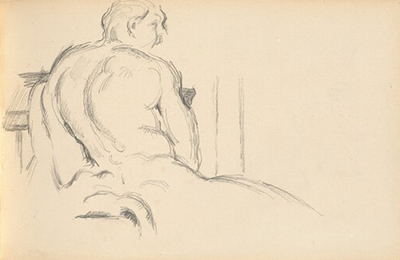 Buy Art Prints Now
Buy Art Prints Nowfrom Amazon
* As an Amazon Associate, and partner with Google Adsense and Ezoic, I earn from qualifying purchases.
Paul Cezanne adored sketching and would do so at every opportunity. His drawings were a mixture of study pieces, such as the one found in front of us here, but also with some personal portraits that he produced more for his own personal enjoyment.
This item was a single entry in a sketchbook from Paul Cezanne, which now resides in the collection of the National Gallery of Art in the USA. It was a part of a selection of work that was bequethed to the institution by the famous Mellon family, who have played a major role within the American art scene. This particular sketchbook carries drawings from the 1870s to the 1890s and most within it were produced using graphite. He did not overly detail anything on this series, concentrating on practicing his craft and developing his understanding of technical challenges such as shadows, facial structure and more. In the example of this study, it is the muscular back that first takes our attention, and we know with certainty that this piece was intended as a means to preparing for a following artwork, most likely a more complex oil painting.
Hercules at Rest was a marble sculpture by Pierre Puget in 1661. The item can be found in the Louvre, which is presumably where Cezanne saw it himself for this study. A man reclines backwards in this famous sculpture, but Cezanne himself chose to study it from behind. This means that most of the detail of the original sculpture is lost, but the French sketcher clearly had reasons for this decision. He worked exclusively from the back of this figure, tracing the outline of an outstretched leg, with the arched back being particularly memorable. Any background detail that surrounded the sculpture is almost entirely ignored and it seems that the purpose of this artwork for Cezanne was to focus on angles of the body that are not normally displayed within mainstream art.
Cezanne produced a large number of portrait paintings during his career and this challenging genre requires endless practice in order to be mastered. Preparation can include either of study drawings, as seen here, or with painted studies where detail is limited. Each artist has their own preferred method, with time being the main concern. Paul Cezanne tended to work with graphite on woven paper and we find this combination throughout the majority of his sketchbooks, though only a few still remain intact today. As someone who inspired so many artists of the 20th century, it is perhaps surprising that more effort has not been made into researching his sketching techniques.



